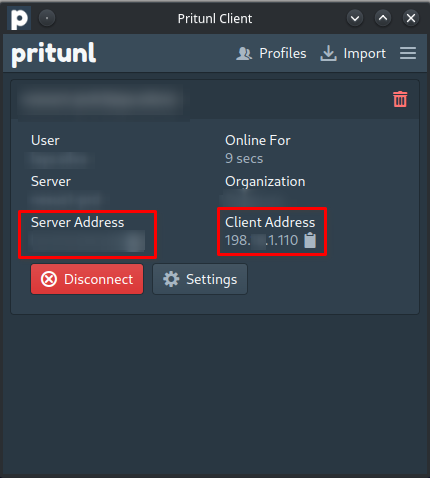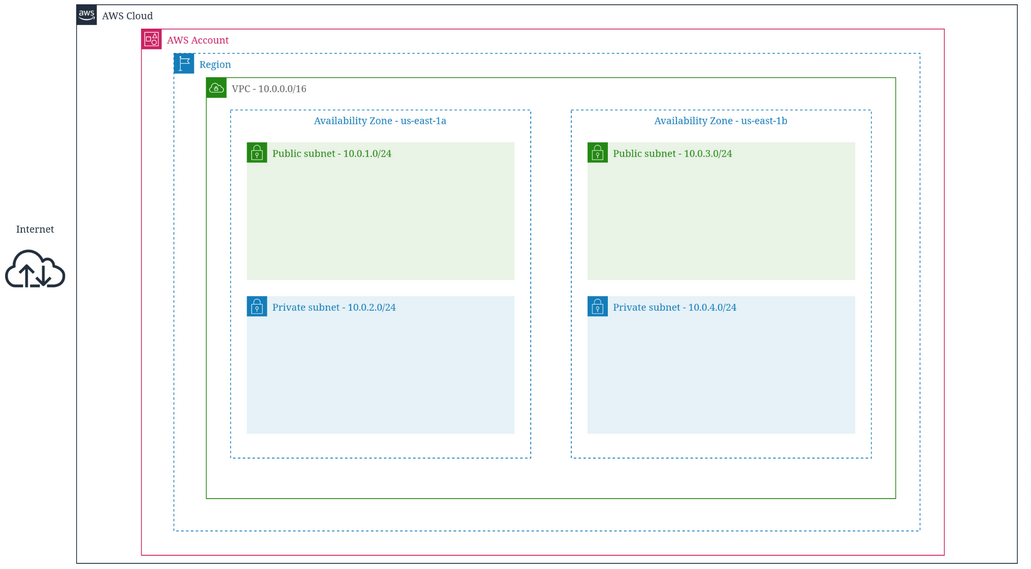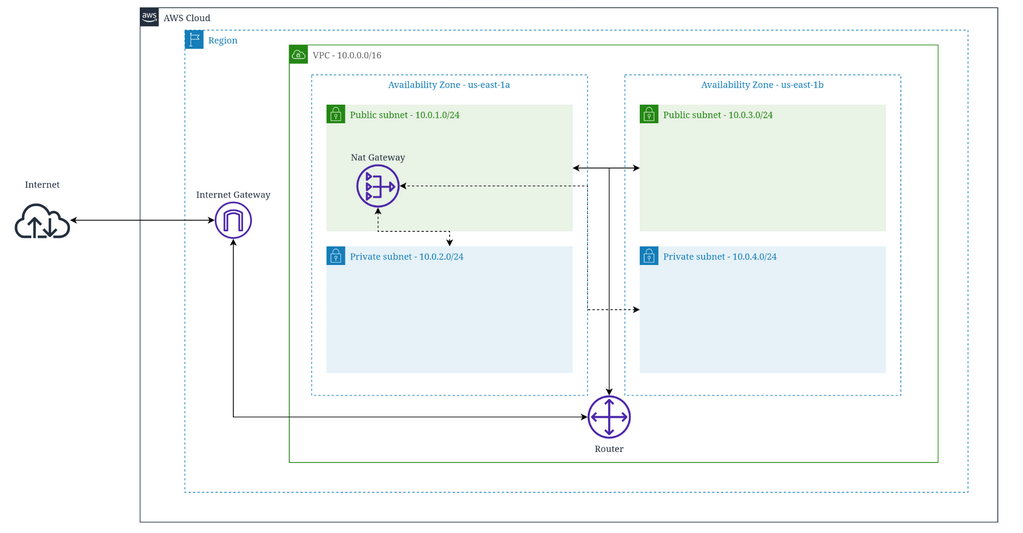AWS Networking 101
Everything that you should know about AWS Networking to get started
Last week I gave a training to my team about AWS Networking. And I realized that this training would be perfect for a post here. So, grab your coffee and let’s start it.
Agenda
Reviewing the Basics
IP's – How do we define a network
CIDR
Private and Public networks
AWS
VPC
Subnets
Routing Table
Internet Gateway
Elastic IP
Nat Gateway
Security Groups and ACL’s
Reviewing the basics
IP’s - How do we define a network
An IP (Internet Protocol) is an internet address that we attach to a resource. Quoting a definition by NordVPN:
Your internet service provider assigns a numeric label, called the Internet Protocol (IP) address, to identify your device among billions of others. In a way, an IP address functions as an online home address because devices use IPs to find and communicate with each other.
There are two formal definitions for an IP: IPv4 and IPv6.
IPv4 is the most common format that you will find around, and you may already see it in the format of 192.168.0.1 on your house network, for example. An IPv4 is defined by a set of 32 bits divided in 4 groups of 8 bits each.
The second format is IPv6, that was created to complement (or substitute) the IPv4 because the latest was reaching its limit in the available addresses that could be used. It is defined by a set of 64 bits, divided in 8 groups of 4 hexadecimals digits: 2804:3d28:12:4438:5ecd:5bff:febc:b862
CIDR → Classless Inter-Domain Routing
A CIDR goes hand by hand with IP’s. A CIDR number defines the size and the addresses available in a network. With the following screenshot, we can see that this network has a mask of /16 where it translates to the network mask. The network mask defines how many bits of the IPv4 address will be frozen and also defines the size of the network.
We can see that a /16 mask, gives the number of 65,536 IPs to be used in the network.
The network mask can go in a range of /8 to /32, where /16 or /24 or /28 can be the most common values used in private networks. You can play with CIDR definition at this website.
Public and Private Networks
A Public Network is reachable by any user on the internet. An example is the github.com website:
A Private Network is a restricted access network most commonly used for house and enterprise networks. Here is an example on how I connect to a VPN using the Pritunl service:
The “Server Address” is a public address that I connect to jump to the private network defined in the “Client Address”, where now I’m able to access my private resources through it.
Let’s build our AWS Network?
What is a VPC?
A VPC1 represents your private network inside AWS. It’s totally isolated and nobody can access it besides2 your account.
In AWS, we can define a VPC’s using a CIDR’s number with a network mask between /16 to /28. It is suggested that you create your VPC using the most known private CIDR’s that are:
The network mask is up to you.
Subnets
A Subnet3 is a subnetwork inside your VPC and is defined by another CIDR, with a different network mask. In other words, we divide the addresses available in the VPC in groups that we call subnets.
Let’s take a small detour and talk about :
Regions and Availability Zones
A Region4 in AWS is defined by a state where AWS provides its services, for example:
us-east-1 represents the state of Virginia in the US
sa-east-1 represents the state of São Paulo in Brazil
An Availability Zones is the redundancy that AWS provides in different datacenters in the same state, for example:
us-east-1[a to f] (6 datacenters)
sa-east-1[a to c] (3 datacenters)
Going back to Subnets:
Good practices to create Subnets
We should create a subnet for each type of resource that we will deploy in our Network:
One for databases
One for caching services
One for containers, etc.
As AWS have redundancy, our network must have too. It is recommended that we have at least 4 subnets(2 public and 2 private) in two different Availability Zones. The ideal is 3 or 4 subnets per public and private networks.5
Tip: The Terraform AWS VPC module will help you to create a VPC and all the required resources without sweat, following all the best practices that we have mentioned here.
State of our Network so far:
Routing Tables
A Routing Table6 represents a group of one or more subnets. It is the router created based on the groups that will handle where the traffic in our VPC will go.
Subnets aren’t the only resource that we can attach to the table. Now let’s learn about them.
Internet Gateway
An Internet Gateway7 allows your VPC to connect to the Internet and vice-versa. We create an Internet Gateway and attach to a Routing Table. Attaching an Internet Gateway to a Routing Table makes the subnets that are attached to it public.
Elastic IP
An Elastic IP8, it’s a public IP address that you can attach to a resource. This resource can be a EC2 or a Nat Gateway, for example. It’s only available for IPv4 addresses, since IPv6 addresses are public. One of the most common uses of an Elastic IP is to attach to a Nat Gateway, that is our next topic.
Nat Gateway
A Nat Gateway9 is a resource that allows our instances that are in the private subnets to connect to the internet, but the “internet” cannot connect to the instances in our VPC. We create the Nat Gateway in a public subnet and attach it to the routing table related to the private subnets.
How can we discover if a subnet is public or private?
If the routing table has an Internet Gateway attached the subnets on it are public, if the routing table has a Nat Gateway attached instead, is a private group of subnets.
Now that we covered the base of AWS Networking, let’s talk about security.
Security Groups
A Security Group10 is created to control the traffic that is allowed to leave or reach the resources associated with it. In this case resources mean: EC2 instances, Containers, Elastic Load Balancers, etc.
In a security group configuration, we can set up Inbound and Outbound rules. For example: If we have an EC2 instance that we want to ssh into it, we need to have an inbound rule that allows connection through the port 22. Or, if our containers need to access a Postgres RDS instance, we have to create an outbound rule that allows the container to reach the instance in the port 5432. It can be attached to one or more resources in our VPC. We can only create “allow” rules for the security groups. When you create an inbound rule, the same port is automatically available for the outbound, removing the need to create an outbound rule for the same port. Everything else is “denied” by default. Check the Security Group documentation for more of the default configuration of this resource.
In other words, the security groups allow us to control what can and cannot access our AWS compute resources, and what our resource can access in or out of the AWS Cloud.
ACL’s
The last resource that we will learn today is the Network Access Control List (NACL’s or ACL’s)11.
The ACL’s works similar to the security groups, but at the subnet level. By default, the rules of an ACL allows all the traffic to reach the networks. The main difference from a security group, besides the attachment to the subnet, is the ability to create deny rules. For example, we can create a rule where we do not allow connections to the port 22(ssh) or 3389(rdp) in our subnets, giving us an extra layer of security, preventing insecure connections to the resources available in the subnets.
Takeaway: The security groups are associated with the AWS resources available in our VPC, and the ACL’s are associated with one or more subnets in our VPC.
Let’s review the resources that we created on this diagram:
→ We have a VPC with the CIDR 10.0.0.0/16, divided in four subnets, where two are public, and two are private divided in two availability zones, with its CIDR’s containing the network mask /24 size.
→ We also have an Internet Gateway associated with our VPC that allows our resources to access the internet, and a Nat Gateway that allows our private subnets to access the internet, deployed in one of the public subnets.
→ Furthermore, we also have 3 security groups: 2 of them for a group of instances and one for an RDS instance. The instances associated with the security-group-02 is allowed to reach the RDS instance by a rule added to the outbound of its security group. And an inbound rule was added to the security-group-3 related to the RDS to allow the instances to access it. The security-group-01 does not have any inbound and outbound rules associated.
→ Finally, we have a router representing our routing tables, managing the connections between our resources in the subnets.
That’s all folks!
https://docs.aws.amazon.com/vpc/latest/userguide/how-it-works.html
Except with the use of VPC Peering.
https://docs.aws.amazon.com/vpc/latest/userguide/configure-subnets.html
https://aws.amazon.com/about-aws/global-infrastructure/regions_az/
https://docs.aws.amazon.com/vpc/latest/userguide/configure-subnets.html
https://docs.aws.amazon.com/vpc/latest/userguide/VPC_Route_Tables.html
https://docs.aws.amazon.com/vpc/latest/userguide/VPC_Internet_Gateway.html
https://docs.aws.amazon.com/vpc/latest/userguide/vpc-eips.html
https://docs.aws.amazon.com/vpc/latest/userguide/vpc-nat-gateway.html
https://docs.aws.amazon.com/vpc/latest/userguide/VPC_SecurityGroups.html
https://docs.aws.amazon.com/vpc/latest/userguide/vpc-network-acls.html







